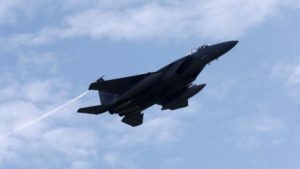Special to WorldTribune.com
Radio Free Europe / Radio Liberty
Russian Deputy Foreign Minister Mikhail Bogdanov said the presence of U.S. forces in Syria was “illegal.”
The Pentagon said a U.S. F-15 aircraft flying over Syrian territory fired on the Shaheed 129 drone after it displayed hostile intent and advanced on coalition forces on June 20.

Pentagon spokesman Navy Captain Jeff Davis said it was Iranian-made and had “dirty wings,” meaning it was armed.
The incident came as Russia once again protested against repeated U.S. actions against forces allied with Syria and United Nations Secretary-General Antonio Guterres warned that the incidents could be “very dangerous” and cause an escalation of the war.
The latest incident occurred in a part of Syria seen as strategically important for the Syrian government and Iran as Tehran seeks to secure a land corridor between forces it backs in Syria and Iraq.
The U.S.-led coalition said the location was close to where another “pro-regime” drone, which intelligence sources had also identified as Iranian, was shot down on June 8 after dropping bombs near coalition forces.
Syrian and Iranian-backed ground forces also have been gathering in the desert region.
The incident follows the U.S. downing of a piloted Syrian Army jet near Raqqa after it dropped bombs near U.S.-backed forces over the weekend, an incident that prompted a warning from Syria ally Russia.
While Russia has demanded an accounting of the weekend incident, Russian Deputy Foreign Minister Mikhail Bogdanov asserted on June 20 that the presence of U.S. forces in Syria was “absolutely illegal.”
“There has been neither a [UN] Security Council decision, nor a request from the official authorities of the Syrian Arab Republic as a sovereign state” for such forces, he told Russia’s Interfax news agency.
But the Pentagon appeared to view Russia’s protests as mostly bluster.
“Public statements aside, we have not seen the Russians do any actions that cause us concern. We continue to operate, making some adjustments for prudent measures,” Davis said on June 20.
The U.S. military has repeatedly warned forces fighting on Assad’s side to stay away from a “deconfliction zone,” agreed with Russia, near a garrison used by U.S. Special Forces and U.S.-backed militia around Al-Tanf, near the border with Jordan.
The U.S.-allied forces are using the base to train for battle and stage attacks against the Islamic State (ISIS) extremist group.
On several occasions in recent weeks, warplanes of the U.S.-led coalition have also struck pro-government forces to prevent them from advancing in the region. The Pentagon also described those strikes as self-defense.
The competition between the Syrian forces and U.S.-backed rebels has increased in the desert region since ISIS extremists abandoned large swathes of the territory as they moved to defend Raqqa and Deir Zor.
